Application of Machine Learning in Electromagnetics: Mini-Review
Abstract
:1. Introduction
2. Familiarization with ML
2.1. Supervised Learning
- i.
- K-Nearest Neighbor (KNN): The concept behind the nearest-neighbor algorithm is to find a predefined number of training samples nearest in distance to the new value and predict the label from them. KNN depends on the surrounding limited samples, rather than relying on the method of discriminating the class domain to determine the value, and the KNN algorithm is more suitable for datasets with crossover or overlap.
- ii.
- Support Vector Machine (SVM): Support Vector Machines (SVMs) are paradigms based on statistical learning theory. They incorporate the structural risk minimization principle, which has been shown to be better than the traditional empirical risk minimization principle used by ANNs. Thus, they have a greater generalization capability. SVMs can solve classification and regression problems and perform well in a high-dimensional feature space. They handle a nonlinear classification efficiently using the kernel trick that implicitly transforms the input space into another high-dimensional feature space.
- iii.
- Gradient Boosting (GB) Tree: The GB tree is an ensemble method that builds one decision tree learner at a time by fitting the gradients of the residuals of the previously constructed tree learners. To build a tree, the method starts from a single node and iteratively adds branches to the tree until a criterion is met. For each leaf, branches are added to maximize the loss reduction after the split (gain function).
- iv.
- Random Forest (RF): The forest operates by forming a multitude of decision trees at training time, and it is mostly trained using the bagging method, which adopts randomly selected training data and then constructs the regressor. Finally, it combines the multiple decision trees to obtain more accurate and stable predictions.
- v.
- Naive Bayes (NB): This generally works as a classifier by utilizing the clustering technique. Clustering occurs considering the conditional probability of the components. Based on the Bayes theorem, it independently predicts the probability of one feature existing over others.
2.2. Unsupervised Learning
2.3. Reinforcement Learning
3. ML and EM
3.1. Design Optimization and Synthesis
3.2. Antenna Selection Applications
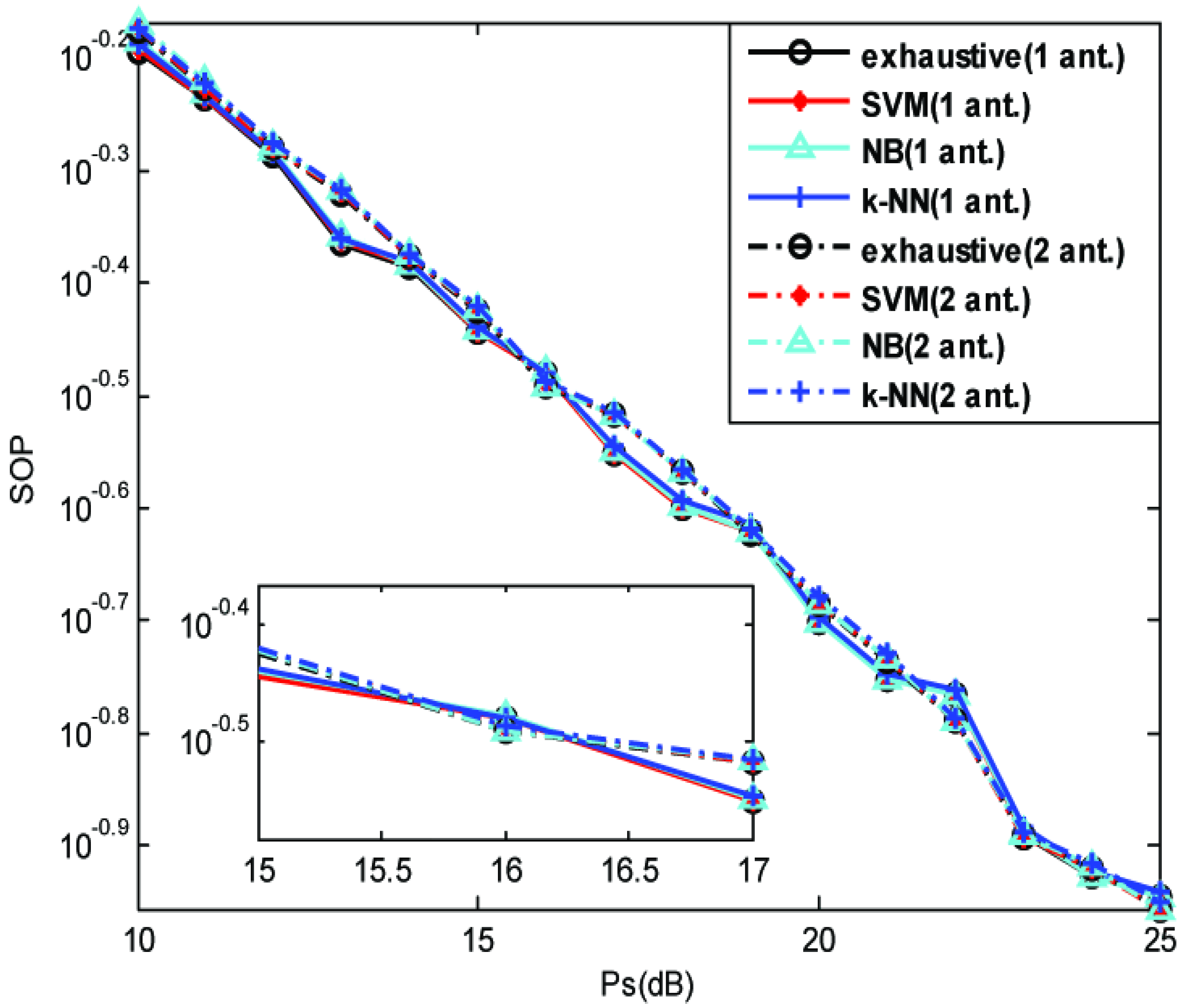
3.3. Antenna Position, Direction, and Radiation Estimation
3.4. Remote Object Detection and Recognition
3.5. Inverse Scattering Problem
3.6. Fault Detection Systems
3.7. Miscellaneous Applications
4. Limitations
5. Future Scope
6. Conclusions
Author Contributions
Funding
Conflicts of Interest
References
- Bansal, R. Engineering Electromagnetics: Applications; CRC Press: Boca Raton, CA, USA, 2006; 297p. [Google Scholar]
- Zhang, Z. Antenna Design for Mobile Devices; John Wiley & Sons: Hoboken, NJ, USA, 2017. [Google Scholar]
- Soltani, S.; Murch, R.D. A Compact Planar Printed MIMO Antenna Design. IEEE Trans. Antennas Propag. 2015, 63, 1140–1149. [Google Scholar] [CrossRef]
- Çalışkan, R.; Gültekin, S.S.; Uzer, D.; Dündar, Ö. A Microstrip Patch Antenna Design for Breast Cancer Detection. Proc. Soc. Behav. Sci. 2015, 195, 2905–2911. [Google Scholar] [CrossRef] [Green Version]
- Robinson, G. Antenna Synthesis Through Characteristic Modal Analysis for Small Unmanned Aerial System Applications. Master’s Thesis, University of Oklahoma, Norman, OK, USA, 2019. [Google Scholar]
- El Gharbi, M.; Fernández-García, R.; Ahyoud, S.; Gil, I. A Review of Flexible Wearable Antenna Sensors: Design, Fabrication Methods, and Applications. Materials 2020, 13, 3781. [Google Scholar] [CrossRef]
- Shlezinger, N.; Alexandropoulos, G.C.; Imani, M.F.; Eldar, Y.C.; Smith, D.R. Dynamic Metasurface Antennas for 6G Extreme Massive MIMO Communications. IEEE Wirel. Commun. 2021, 28, 106–113. [Google Scholar] [CrossRef]
- Nadeem, I.; Alibakhshikenari, M.; Babaeian, F.; Althuwayb, A.A.; Virdee, B.S.; Azpilicueta, L.; Khan, S.; Huynen, I.; Falcone, F.; Denidni, T.A.; et al. A Comprehensive Survey on ‘Circular Polarized Antennas’ for Existing and Emerging Wireless Communication Technologies. J. Phys. D. Appl. Phys. 2021, 55, 033002. [Google Scholar] [CrossRef]
- Wang, J.; Lim, E.G.; Leach, M.P.; Wang, Z.; Pei, R.; Jiang, Z.; Huang, Y. A 403 MHz Wireless Power Transfer System with Tuned Split-Ring Loops for Implantable Medical Devices. IEEE Trans. Antennas Propag. 2021, 1. [Google Scholar] [CrossRef]
- Siddiqi, M.A.; Beurskens, R.H.S.H.; Kruizinga, P.; De Zeeuw, C.I.; Strydis, C. Securing Implantable Medical Devices Using Ultrasound Waves. IEEE Access 2021, 9, 80170–80182. [Google Scholar] [CrossRef]
- Yang, H.; Liu, X. Screen-Printed Dual-Band and Dual-Circularly Polarized Textile Antenna for Wearable Applications. In Proceedings of the 15th European Conference on Antennas and Propagation (EuCAP), Dusseldorf, Germany, 22–26 March 2021. [Google Scholar] [CrossRef]
- Bhattacharjee, M.; Nikbakhtnasrabadi, F.; Dahiya, R. Printed Chipless Antenna as Flexible Temperature Sensor. IEEE Internet Things J. 2021, 8, 5101–5110. [Google Scholar] [CrossRef]
- Ibanez-Labiano, I.; Nourinovin, S.; Alomainy, A. Graphene Inkjet-Printed Ultrawideband Tapered Coplanar-Waveguide Antenna on Kapton Substrate. In Proceedings of the 15th European Conference on Antennas and Propagation (EuCAP), Dusseldorf, Germany, 22–26 March 2021. [Google Scholar] [CrossRef]
- Kumar, S.; Nandan, D.; Srivastava, K.; Kumar, S.; Singh, H.; Marey, M.; Mostafa, H.; Kanaujia, B.K. Wideband Circularly Polarized Textile MIMO Antenna for Wearable Applications. IEEE Access 2021, 9, 108601–108613. [Google Scholar] [CrossRef]
- Tsaliovich, A.; Haridim, M.; Gavan, J. A Critical Note on the Engineering Model of Radiating Antenna in Homogeneous Medium: Field Regions and Transition Zone Boundaries. IEEE Electromagn. Compat. Mag. 2021, 10, 41–50. [Google Scholar] [CrossRef]
- Koziel, S.; Pietrenko-Dabrowska, A. Reliable EM-Driven Size Reduction of Antenna Structures by Means of Adaptive Penalty Factors. IEEE Trans. Antennas Propag. 2021, 1. [Google Scholar] [CrossRef]
- Kumar, S.; Dixit, A.S.; Malekar, R.R.; Raut, H.D.; Shevada, L.K. Fifth Generation Antennas: A Comprehensive Review of Design and Performance Enhancement Techniques. IEEE Access 2020, 8, 163568–163593. [Google Scholar] [CrossRef]
- Rahman, S.; Alam, S.; Haque, M.; Siddique, N.S.; Sagor, M.H. Transparent and Flexible Y-Shaped Antenna for 5G Wireless Applications. In Proceedings of the 12th European Conference on Antennas and Propagation (EuCAP 2018), London, UK, 9–13 April 2018. [Google Scholar] [CrossRef]
- Rani, S.; Sivia, J.S. Design and Development of Virtual Instrument for Fault Diagnosis in Fractal Antenna Array. Int. J. RF Microw. Comput. Eng. 2020, 30, e22026. [Google Scholar] [CrossRef]
- Wei, Z.; Chen, X. Deep-Learning Schemes for Full-Wave Nonlinear Inverse Scattering Problems. IEEE Trans. Geosci. Remote Sens. 2019, 57, 1849–1860. [Google Scholar] [CrossRef]
- El Misilmani, H.M.; Naous, T.; Al Khatib, S.K. A Review on the Design and Optimization of Antennas Using Machine Learning Algorithms and Techniques. Int. J. RF Microw. Comput. Eng. 2020, 30, 1–28. [Google Scholar] [CrossRef]
- Passos, F.; Roca, E.; Castro-López, R.; Fernández, F.V. Radio-Frequency Inductor Synthesis Using Evolutionary Computation and Gaussian-Process Surrogate Modeling. Appl. Soft Comput. 2017, 60, 495–507. [Google Scholar] [CrossRef] [Green Version]
- Plonis, D.; Katkevicius, A.; Gurskas, A.; Urbanavicius, V.; Maskeliunas, R.; Damasevicius, R. Prediction of Meander Delay System Parameters for Internet-of-Things Devices Using Pareto-Optimal Artificial Neural Network and Multiple Linear Regression. IEEE Access 2020, 8, 39525–39535. [Google Scholar] [CrossRef]
- Zhang, J.; Akinsolu, M.O.; Liu, B.; Vandenbosch, G.A.E. Automatic AI-Driven Design of Mutual Coupling Reducing Topologies for Frequency Reconfigurable Antenna Arrays. IEEE Trans. Antennas Propag. 2021, 69, 1831–1836. [Google Scholar] [CrossRef]
- Pietrenko-Dabrowska, A.; Koziel, S. Cost-Efficient Surrogate Modeling of High-Frequency Structures Using Nested Kriging with Automated Adjustment of Model Domain Lateral Dimensions. AEU Int. J. Electron. Commun. 2020, 121, 153224. [Google Scholar] [CrossRef]
- Ertel, W. Introduction to Artificial Intelligence; Springer: Berlin, Germany, 2018. [Google Scholar]
- Langley, P.; Simon, H.A. Applications of Machine Learning and Rule Induction. Commun. ACM 1995, 38, 54–64. [Google Scholar] [CrossRef]
- Mahesh, B. Machine Learning Algorithms-A Review. Int. J. Sci. Res. 2018. [Google Scholar] [CrossRef]
- Haykin, S. Neural Networks and Learning Machines, 3/E.; Pearson Education India: Bengaluru, India, 2010. [Google Scholar]
- Liaw, A.; Wiener, M. Classification and Regression by RandomForest. R News 2002, 2, 18–22. [Google Scholar]
- Friedman, J.H. Stochastic Gradient Boosting. Comput. Stat. Data Anal. 2002, 38, 367–378. [Google Scholar] [CrossRef]
- Kotsiantis, S.B.; Zaharakis, I.; Pintelas, P. Supervised Machine Learning: A Review of Classification Techniques. Emerg. Artif. Intell. Appl. Comput. Eng. 2007, 160, 3–24. [Google Scholar]
- Le, Q.V. Building High-Level Features Using Large Scale Unsupervised Learning. In Proceedings of the 2013 IEEE International Conference on Acoustics, Speech and Signal Processing, Vancouver, BC, Canada, 26–31 May 2013; pp. 8595–8598. [Google Scholar] [CrossRef] [Green Version]
- Bonaccorso, G. Machine Learning Algorithms; Packt Publishing Ltd.: Birmingham, UK, 2017. [Google Scholar]
- Nyangwarimam Obadiah, A.; Hamid, M.R.; Rahim, M.K.A.; Murad, N.A. A Review on Filter-Antennas. Appl. Mech. Mater. 2015, 735, 289–293. [Google Scholar] [CrossRef]
- Akinsolu, M.O.; Mistry, K.K.; Liu, B.; Lazaridis, P.I.; Excell, P. Machine Learning-Assisted Antenna Design Optimization: A Review and the State-of-the-Art. In Proceedings of the 14th European Conference on Antennas and Propagation (EuCAP), Copenhagen, Denmark, 15–20 March 2020. [Google Scholar] [CrossRef]
- Maeurer, C.; Futter, P.; Gampala, G. Antenna Design Exploration and Optimization Using Machine Learning. In Proceedings of the 14th European Conference on Antennas and Propagation (EuCAP), Copenhagen, Denmark, 15–20 March 2020. [Google Scholar] [CrossRef]
- Sahal, M.; Tiwari, V.; Jhajhria, T. Optimization Algorithms for Antenna Design, Array Thinning, and Radiation Pattern Synthesis, Proceedings of International Conference on Communication and Computational Technologies, Jaipur, India, 30–31 August 2019; Algorithms for Intelligent Systems; Springer: Singapore, 2021; pp. 319–326. [Google Scholar] [CrossRef]
- Li, Y.; Lei, G.; Bramerdorfer, G.; Peng, S.; Sun, X.; Zhu, J. Machine Learning for Design Optimization of Electromagnetic Devices: Recent Developments and Future Directions. Appl. Sci. 2021, 11, 1627. [Google Scholar] [CrossRef]
- Lecci, M.; Testolina, P.; Rebato, M.; Testolin, A.; Zorzi, M. Machine Learning-Aided Design of Thinned Antenna Arrays for Optimized Network Level Performance. In Proceedings of the 14th European Conference on Antennas and Propagation (EuCAP), Copenhagen, Denmark, 15–20 March 2020. [Google Scholar] [CrossRef]
- Koziel, S.; Pietrenko-Dabrowska, A. Rapid Multi-Criterial Antenna Optimization by Means of Pareto Front Triangulation and Interpolative Design Predictors. IEEE Access 2021, 9, 35670–35680. [Google Scholar] [CrossRef]
- Forrester, A.I.J.; Keane, A.J. Recent Advances in Surrogate-Based Optimization. Prog. Aerosp. Sci. 2009, 45, 50–79. [Google Scholar] [CrossRef]
- Jacobs, J.P.; Koziel, S. Two-Stage Framework for Efficient Gaussian Process Modeling of Antenna Input Characteristics. IEEE Trans. Antennas Propag. 2014, 62, 706–713. [Google Scholar] [CrossRef] [Green Version]
- Wu, Q.; Wang, H.; Hong, W. Multistage Collaborative Machine Learning and Its Application to Antenna Modeling and Optimization. IEEE Trans. Antennas Propag. 2020, 68, 3397–3409. [Google Scholar] [CrossRef]
- Liu, B.; Akinsolu, M.O.; Ali, N.; Abd-Alhameed, R. Efficient Global Optimisation of Microwave Antennas Based on a Parallel Surrogate Model-Assisted Evolutionary Algorithm. IET Microwaves, Antennas Propag. 2019, 13, 149–155. [Google Scholar] [CrossRef] [Green Version]
- Liu, B.; Akinsolu, M.O.; Song, C.; Hua, Q.; Excell, P.; Xu, Q.; Huang, Y.; Imran, M.A. An Efficient Method for Complex Antenna Design Based on a Self Adaptive Surrogate Model-Assisted Optimization Technique. IEEE Trans. Antennas Propag. 2021, 69, 2302–2315. [Google Scholar] [CrossRef]
- Koziel, S.; Ogurtsov, S.; Couckuyt, I.; Dhaene, T. Variable-Fidelity Electromagnetic Simulations and Co-Kriging for Accurate Modeling of Antennas. IEEE Trans. Antennas Propag. 2013, 61, 1301–1308. [Google Scholar] [CrossRef] [Green Version]
- Gao, J.; Tian, Y.; Chen, X. Antenna Optimization Based on Co-Training Algorithm of Gaussian Process and Support Vector Machine. IEEE Access 2020, 8, 211380–211390. [Google Scholar] [CrossRef]
- Xue, M.; Shi, D.; He, Y.; Li, C. A Novel Intelligent Antenna Synthesis System Using Hybrid Machine Learning Algorithms. In Proceedings of the 2019 International Symposium on Electromagnetic Compatibility—EMC EUROPE, Barcelona, Spain, 2–6 September 2019; pp. 902–907. [Google Scholar] [CrossRef]
- Kim, Y.; Seo, C. High-Efficiency and Compact WPT Receiving Antenna Design Using Simulation Optimization Method. Int. J. Electr. Eng. Educ. 2021. [Google Scholar] [CrossRef]
- Danesh, S.; Araghi, A.; Khalily, M.; Xiao, P.; Tafazolli, R. Millimeter Wave Phased Array Antenna Synthesis Using a Machine Learning Technique for Different 5G Applications. In Proceedings of the 2020 International Symposium on Networks, Computers and Communications (ISNCC), Montreal, QC, Canada, 20–22 October 2020. [Google Scholar] [CrossRef]
- Shan, T.; Li, M.; Xu, S.; Yang, F. Synthesis of Refiectarray Based on Deep Learning Technique. In Proceedings of the 2018 Cross Strait Quad-Regional Radio Science and Wireless Technology Conference (CSQRWC), Xuzhou, China, 21–24 July 2018. [Google Scholar] [CrossRef]
- Song, Y.; Wen, Y.; Zhang, D.; Zhang, J. Fast Prediction Model of Coupling Coefficient between Pantograph Arcing and GSM-R Antenna. IEEE Trans. Veh. Technol. 2020, 69, 11612–11618. [Google Scholar] [CrossRef]
- Sharma, K.; Pandey, G.P. Designing a Compact Microstrip Antenna Using the Machine Learning Approach. J. Telecommun. Inf. Technol. 2020, nr 4, 44–52. [Google Scholar] [CrossRef]
- Singh, B.K. Design of Rectangular Microstrip Patch Antenna Based on Artificial Neural Network Algorithm. In Proceedings of the 2nd International Conference on Signal Processing and Integrated Networks (SPIN), Noida, India, 19–20 February 2015; pp. 6–9. [Google Scholar] [CrossRef]
- Ayestarán, R.G. Support Vector Regression for the Modeling and Synthesis of Near-Field Focused Antenna Arrays. Electronics 2019, 8, 1352. [Google Scholar] [CrossRef] [Green Version]
- Xiao, L.Y.; Shao, W.; Jin, F.L.; Wang, B.Z.; Liu, Q.H. Inverse Artificial Neural Network for Multi-Objective Antenna Design. IEEE Trans. Antennas Propag. 2021, 6651–6659. [Google Scholar] [CrossRef]
- Gosal, G.; Almajali, E.; McNamara, D.; Yagoub, M. Transmitarray Antenna Design Using Forward and Inverse Neural Network Modeling. IEEE Antennas Wirel. Propag. Lett. 2016, 15, 1483–1486. [Google Scholar] [CrossRef]
- Sharma, Y.; Zhang, H.H.; Xin, H. Machine Learning Techniques for Optimizing Design of Double T-Shaped Monopole Antenna. IEEE Trans. Antennas Propag. 2020, 68, 5658–5663. [Google Scholar] [CrossRef]
- Cui, L.; Zhang, Y.; Zhang, R.; Liu, Q.H. A Modified Efficient KNN Method for Antenna Optimization and Design. IEEE Trans. Antennas Propag. 2020, 68, 6858–6866. [Google Scholar] [CrossRef]
- Lovato, R.; Gong, X. Phased Antenna Array Beamforming Using Convolutional Neural Networks. In Proceedings of the 2019 IEEE International Symposium on Antennas and Propagation and USNC-URSI Radio Science Meeting, Atlanta, GA, USA, 7–12 July 2019; pp. 1247–1248. [Google Scholar] [CrossRef]
- Kim, J.H.; Choi, S.W. A Deep Learning-Based Approach for Radiation Pattern Synthesis of an Array Antenna. IEEE Access 2020, 8, 226059–226063. [Google Scholar] [CrossRef]
- Chen, Z.R.; Kai Guan, K.; Tong, M.S. An Improved Adaptive Chaotic Particle Swarm Optimization Algorithm for Antenna Synthesis. In Proceedings of the 2019 Photonics & Electromagnetics Research Symposium—Fall (PIERS—Fall), Xiamen, China, 17–20 December 2019; pp. 207–210. [Google Scholar] [CrossRef]
- Zhang, X.Y.; Tian, Y.B.; Zheng, X. Antenna Optimization Design Based on Deep Gaussian Process Model. Int. J. Antennas Propag. 2020, 2020. [Google Scholar] [CrossRef]
- Hu, C.; Zhao, J.P.; Xu, J. Optimization of Dielectric Resonator Antenna Based on Machine Learning and PSO Methods. In Proceedings of the 2020 International Conference on Microwave and Millimeter Wave Technology (ICMMT), Shanghai, China, 20–23 September 2020. [Google Scholar] [CrossRef]
- Calik, N.; Belen, M.A.; Mahouti, P. Deep Learning Base Modified MLP Model for Precise Scattering Parameter Prediction of Capacitive Feed Antenna. Int. J. Numer. Model. Electron. Netw. Devices Fields 2020, 33, e2682. [Google Scholar] [CrossRef]
- Aoad, A. Design and Manufacture of a Multiband Rectangular Spiral-Shaped Microstrip Antenna Using EM-Driven and Machine Learning. Elektron. Elektrotech. 2021, 27, 29–40. [Google Scholar] [CrossRef]
- Kazemian, A.; Wang, P.; Yi, Y.; Zhuang, Y.; Zhuang, Y.; Yi, Y. Optimization of the Silicon-Based Aperiodic Optical Phased Array Antenna. Opt. Lett. 2021, 46, 801–804. [Google Scholar] [CrossRef]
- Rudant, L.; Batel, L.; Clemente, A.; Delaveaud, C. New Approach in Antenna Design Automation Applied to a Dual-Band GNSS Micro-Array. In Proceedings of the 15th European Conference on Antennas and Propagation (EuCAP), Dusseldorf, Germany, 22–26 March 2021. [Google Scholar] [CrossRef]
- Gecgel, S.; Goztepe, C.; Kurt, G.K. Transmit Antenna Selection for Large-Scale MIMO GSM with Machine Learning. IEEE Wirel. Commun. Lett. 2020, 9, 113–116. [Google Scholar] [CrossRef]
- de Souza Junior, W.; Alves, T.A.B.; Abrão, T. Antenna Selection in Nonorthogonal Multiple Access Multiple-Input Multiple-Output Systems Aided by Machine Learning. Trans. Emerg. Telecommun. Technol. 2021, 32, e4283. [Google Scholar] [CrossRef]
- He, D.; Liu, C.; Quek, T.Q.S.; Wang, H. Transmit Antenna Selection in MIMO Wiretap Channels: A Machine Learning Approach. IEEE Wirel. Commun. Lett. 2018, 7, 634–637. [Google Scholar] [CrossRef]
- Yao, R.; Zhang, Y.; Qi, N.; Tsiftsis, T.A.; Liu, Y. Machine Learning-Based Antenna Selection in Untrusted Relay Networks. In Proceedings of the 2nd International Conference on Artificial Intelligence and Big Data (ICAIBD), Chengdu, China, 25–28 May 2019; pp. 323–328. [Google Scholar] [CrossRef] [Green Version]
- An, W.; Zhang, P.; Xu, J.; Luo, H.; Huang, L.; Zhong, S. A Novel Machine Learning Aided Antenna Selection Scheme for MIMO Internet of Things. Sensors 2020, 20, 2250. [Google Scholar] [CrossRef]
- Diamantaras, K.; Xu, Z.; Petropulu, A. Sparse Antenna Array Design for MIMO Radar Using Softmax Selection. arXiv 2021, arXiv:2102.05092. [Google Scholar]
- Zhong, S.; Feng, H.; Zhang, P.; Xu, J.; Luo, H.; Zhang, J.; Yuan, T.; Huang, L. Deep Learning Based Antenna Selection for MIMO SDR System. Sensors 2020, 20, 6987. [Google Scholar] [CrossRef]
- Ma, Y.; Hao, Y. Antenna Classification Using Gaussian Mixture Models (GMM) and Machine Learning. IEEE Open J. Antennas Propag. 2020, 1, 320–328. [Google Scholar] [CrossRef]
- Vu, T.X.; Chatzinotas, S.; Nguyen, V.D.; Hoang, D.T.; Nguyen, D.N.; Di Renzo, M.; Ottersten, B. Machine Learning-Enabled Joint Antenna Selection and Precoding Design: From Offline Complexity to Online Performance. IEEE Trans. Wirel. Commun. 2021, 20, 3710–3722. [Google Scholar] [CrossRef]
- Cenkeramaddi, L.R.; Rai, P.K.; Dayal, A.; Bhatia, J.; Pandya, A.; Soumya, J.; Kumar, A.; Jha, A. A Novel Angle Estimation for MmWave FMCW Radars Using Machine Learning. IEEE Sens. J. 2021, 21, 9833–9843. [Google Scholar] [CrossRef]
- Sun, R.; Wang, G.; Cheng, Q.; Fu, L.; Chiang, K.W.; Hsu, L.T.; Ochieng, W.Y. Improving GPS Code Phase Positioning Accuracy in Urban Environments Using Machine Learning. IEEE Internet Things J. 2021, 8, 7065–7078. [Google Scholar] [CrossRef]
- Barthelme, A.; Utschick, W. A Machine Learning Approach to DoA Estimation and Model Order Selection for Antenna Arrays with Subarray Sampling. IEEE Trans. Signal Process. 2021, 3075–3087. [Google Scholar] [CrossRef]
- Lv, Y.; Zhen, J.; Guo, B. Accessorial Locating for Internet of Vehicles Based on DOA Estimation in Industrial Transportation. Wirel. Commun. Mob. Comput. 2021, 2021, 1–10. [Google Scholar] [CrossRef]
- Yang, T.; Zheng, J.; Su, T.; Liu, H. Fast and Robust Super-Resolution DOA Estimation for UAV Swarms. Signal Process. 2021, 188, 108187. [Google Scholar] [CrossRef]
- Vu, T.X.; Lei, L.; Chatzinotas, S.; Ottersten, B. Machine Learning Based Antenna Selection and Power Allocation in Multi-User MISO Systems. In Proceedings of the 2019 International Symposium on Modeling and Optimization in Mobile, Ad Hoc, and Wireless Networks (WiOPT), Avignon, France, 3–7 June 2019. [Google Scholar] [CrossRef]
- Karim, A.K.; Shanmugha Sundaram, G.A. Optimisation of Articulated Vehicular RADAR Antenna Array Parameters Using Machine Learning Algorithms. Lect. Notes Networks Syst. 2021, 154, 517–526. [Google Scholar] [CrossRef]
- Ma, W.; Qi, C.; Li, G.Y. Machine Learning for Beam Alignment in Millimeter Wave Massive MIMO. IEEE Wirel. Commun. Lett. 2020, 9, 875–878. [Google Scholar] [CrossRef]
- Hong, T.; Liu, C.; Kadoch, M. Machine Learning Based Antenna Design for Physical Layer Security in Ambient Backscatter Communications. Wirel. Commun. Mob. Comput. 2019, 2019. [Google Scholar] [CrossRef]
- Sharma, K.; Pandey, G.P. Efficient Modelling of Compact Microstrip Antenna Using Machine Learning. AEU Int. J. Electron. Commun. 2021, 135, 153739. [Google Scholar] [CrossRef]
- Akdag, I.; Gocen, C.; Palandoken, M.; Kaya, A. Estimation of the Scattering Parameter at the Resonance Frequency of the UHF Band of the E-Shaped RFID Antenna Using Machine Learning Techniques. In Proceedings of the 4th International Symposium on Multidisciplinary Studies and Innovative Technologies (ISMSIT), Istanbul, Turkey, 22–24 October 2020. [Google Scholar] [CrossRef]
- Soni, M.; Sharma, K.; Pandey, G.P.; Gupta, S.K. Resonant Frequency Prediction of Patch Antenna in the Presence of Inserted Airgap Using Machine Learning. Lect. Notes Electr. Eng. 2021, 721 LNEE, 353–361. [Google Scholar] [CrossRef]
- Shi, L.P.; Zhang, Q.H.; Zhang, S.H.; Liu, G.X.; Yi, C. Application of Machine Learning Method to the Prediction of Em Response of Reflectarray Antenna Elements. In Proceedings of the 2019 Photonics & Electromagnetics Research Symposium—Fall (PIERS—Fall), Xiamen, China, 17–20 December 2019; pp. 2671–2676. [Google Scholar] [CrossRef]
- Subramani, P.; Al-Turjman, F.; Kumar, R.; Kannan, A.; Loganthan, A. Improving Medical Communication Process Using Recurrent Networks and Wearable Antenna S11 Variation with Harmonic Suppressions. Pers. Ubiquitous Comput. 2021, 2021, 1–13. [Google Scholar] [CrossRef]
- Chen, M.; Gong, Y.; Mao, X. Deep Neural Network for Estimation of Direction of Arrival with Antenna Array. IEEE Access 2020, 8, 140688–140698. [Google Scholar] [CrossRef]
- Liu, Q.; Yang, J.; Zhuang, C.; Barnawi, A.; Alzahrani, B.A. Artificial Intelligence Based Mobile Tracking and Antenna Pointing in Satellite-Terrestrial Network. IEEE Access 2019, 7, 177497–177503. [Google Scholar] [CrossRef]
- Lutati, S.; Wolf, L. HyperHyperNetworks for the Design of Antenna Arrays. arXiv 2021, arXiv:2105.03838. [Google Scholar]
- Aumayr, E.; Feghhi, S.; Vannella, F.; Al Hakim, E.; Iakovidis, G. A Safe Reinforcement Learning Architecture for Antenna Tilt Optimisation. arXiv 2020, arXiv:2012.01296. [Google Scholar]
- Reji, V.; Manimegalai, C.T. V-Shaped Long Wire Frequency Reconfigurable Antenna for WLAN and ISM Band Applications. AEU Int. J. Electron. Commun. 2021, 140, 153937. [Google Scholar] [CrossRef]
- Elwi, T.A. Remotely Controlled Reconfigurable Antenna for Modern 5G Networks Applications. Microw. Opt. Technol. Lett. 2021, 63, 2018–2023. [Google Scholar] [CrossRef]
- Qin, P.; Wang, L.; Liu, T.-Y.; Wang, Q.-Y.; Fu, J.-H.; Huang, G.-L.; Gui, L.; Liu, J.; Deng, Z.-S. The Design and Manufacturing Process of an Electrolyte-Free Liquid Metal Frequency-Reconfigurable Antenna. Sensors 2021, 21, 1793. [Google Scholar] [CrossRef]
- Mohamadzade, B.; Simorangkir, R.B.V.B.; Hashmi, R.M.; Gharaei, R.; Lalbakhsh, A.; Shrestha, S.; Zhadobov, M.; Sauleau, R. A Conformal, Dynamic Pattern-Reconfigurable Antenna Using Conductive Textile-Polymer Composite. IEEE Trans. Antennas Propag. 2021, 6175–6184. [Google Scholar] [CrossRef]
- Bakar, H.A.; Rahim, R.A.; Soh, P.J.; Akkaraekthalin, P. Liquid-Based Reconfigurable Antenna Technology: Recent Developments, Challenges and Future. Sensors 2021, 21, 827. [Google Scholar] [CrossRef]
- Kaur, N.; Sivia, J.S.; Rajni. Artificial Neural Network Based Metasurface Inspired Planar Frequency Reconfigurable Antenna for Wireless Applications. Int. J. RF Microw. Comput. Eng. 2021, 31, e22793. [Google Scholar] [CrossRef]
- Yang, S.; Khusro, A.; Li, W.; Vaseem, M.; Hashmi, M.; Shamim, A. A Machine Learning-Based Microwave Device Model for Fully Printed VO2 RF Switches. In Proceedings of the 50th European Microwave Conference (EuMC), Utrecht, The Netherlands, 12–14 January 2021; pp. 662–665. [Google Scholar]
- Zardi, F.; Nayeri, P.; Rocca, P.; Haupt, R. Artificial Intelligence for Adaptive and Reconfigurable Antenna Arrays: A Review. IEEE Antennas Propag. Mag. 2021, 63, 28–38. [Google Scholar] [CrossRef]
- Cetiner, B. The Development of Efficient and Intelligent Algorithms for a New Class of Multifunctional Reconfigurable Antenna Systems; Defense Technical Information Center: Fort Belvoir, VA, USA, 2019. [Google Scholar]
- Ding, J.; Chen, B.; Liu, H.; Huang, M. Convolutional Neural Network with Data Augmentation for SAR Target Recognition. IEEE Geosci. Remote Sens. Lett. 2016, 13, 364–368. [Google Scholar] [CrossRef]
- Chen, S.; Wang, H.; Xu, F.; Jin, Y.Q. Target Classification Using the Deep Convolutional Networks for SAR Images. IEEE Trans. Geosci. Remote Sens. 2016, 54, 4806–4817. [Google Scholar] [CrossRef]
- Al Mufti, M.; Al Hadhrami, E.; Taha, B.; Werghi, N. SAR Automatic Target Recognition Using Transfer Learning Approach. In Proceedings of the 2018 International Conference on Intelligent Autonomous Systems (ICoIAS), Singapore, 1–3 March 2018; pp. 1–4. [Google Scholar] [CrossRef]
- Pei, J.; Huang, Y.; Huo, W.; Zhang, Y.; Yang, J.; Yeo, T.S. SAR Automatic Target Recognition Based on Multiview Deep Learning Framework. IEEE Trans. Geosci. Remote Sens. 2018, 56, 2196–2210. [Google Scholar] [CrossRef]
- Dbouk, H.; Geng, H.; Vineyard, C.M.; Shanbhag, N.R. Low-Complexity Fixed-Point Convolutional Neural Networks for Automatic Target Recognition. In Proceedings of the ICASSP 2020—2020 IEEE International Conference on Acoustics, Speech and Signal Processing (ICASSP), Barcelona, Spain, 4–8 May 2020; pp. 1598–1602. [Google Scholar] [CrossRef]
- Huang, X.; Yang, Q.; Qiao, H. Lightweight Two-Stream Convolutional Neural Network for SAR Target Recognition. IEEE Geosci. Remote Sens. Lett. 2021, 18, 667–671. [Google Scholar] [CrossRef]
- Chen, X. Subspace-Based Optimization Method for Solving Inverse-Scattering Problems. IEEE Trans. Geosci. Remote Sens. 2010, 48, 42–49. [Google Scholar] [CrossRef]
- Chew, W.C.; Wang, Y.M. Reconstruction of Two-Dimensional Permittivity Distribution Using the Distorted Born Iterative Method. IEEE Trans. Med. Imaging 1990, 9, 218–225. [Google Scholar] [CrossRef]
- Van den Berg, P.; Abubakar, A. Contrast Source Inversion Method: State of Art. Prog. Electromagn. Res. 2001, 34, 189–218. [Google Scholar] [CrossRef] [Green Version]
- Pastorino, M. Stochastic Optimization Methods Applied to Microwave Imaging: A Review. IEEE Trans. Antennas Propag. 2007, 55, 538–548. [Google Scholar] [CrossRef]
- Massa, A.; Oliveri, G.; Salucci, M.; Anselmi, N.; Rocca, P. Learning-by-Examples Techniques as Applied to Electromagnetics. J. Electromagn. Waves Appl. 2017, 32, 516–541. [Google Scholar] [CrossRef]
- Ronneberger, O.; Fischer, P.; Brox, T. U-Net: Convolutional Networks for Biomedical Image Segmentation. Lect. Notes Comput. Sci. 2015, 9351, 234–241. [Google Scholar] [CrossRef] [Green Version]
- Li, L.; Wang, L.G.; Teixeira, F.L.; Liu, C.; Nehorai, A.; Cui, T.J. DeepNIS: Deep Neural Network for Nonlinear Electromagnetic Inverse Scattering. IEEE Trans. Antennas Propag. 2019, 67, 1819–1825. [Google Scholar] [CrossRef] [Green Version]
- Wei, Z.; Chen, X. Physics-Inspired Convolutional Neural Network for Solving Full-Wave Inverse Scattering Problems. IEEE Trans. Antennas Propag. 2019, 67, 6138–6148. [Google Scholar] [CrossRef]
- Agarwal, K.; Pan, L.; Yeo, S.P.; Chen, X.; Zhong, Y. Subspace-Based Optimization Method for Reconstructing Extended Scatterers: Transverse Electric Case. JOSA A 2009, 26, 1932–1937. [Google Scholar] [CrossRef]
- Sanghvi, Y.; Kalepu, Y.; Khankhoje, U.K. Embedding Deep Learning in Inverse Scattering Problems. IEEE Trans. Comput. Imaging 2019, 6, 46–56. [Google Scholar] [CrossRef]
- Yao, H.M.; Sha, W.E.I.; Jiang, L. Two-Step Enhanced Deep Learning Approach for Electromagnetic Inverse Scattering Problems. IEEE Antennas Wirel. Propag. Lett. 2019, 18, 2254–2258. [Google Scholar] [CrossRef]
- Guo, R.; Song, X.; Li, M.; Yang, F.; Xu, S.; Abubakar, A. Supervised Descent Learning Technique for 2-D Microwave Imaging. IEEE Trans. Antennas Propag. 2019, 67, 3550–3554. [Google Scholar] [CrossRef]
- Xu, K.; Wu, L.; Ye, X.; Chen, X. Deep Learning-Based Inversion Methods for Solving Inverse Scattering Problems with Phaseless Data. IEEE Trans. Antennas Propag. 2020, 68, 7457–7470. [Google Scholar] [CrossRef]
- Fondevila-Gomez, J.; Rodriguez, J.A.; Ares, F.; Moreno, E. A Simple Way of Obtaining Optimized Patterns Using the Woodward-Lawson Method. In Proceedings of the 2006 IEEE Antennas and Propagation Society International Symposium, Albuquerque, NM, USA, 9–14 July 2006; pp. 3383–3386. [Google Scholar] [CrossRef]
- Iglesias, R.; Ares, F.; Fernández-Delgado, M.; Rodríguez, J.A.; Brégains, J.; Barro, S. Element Failure Detection in Linear Antenna Arrays Using Case-Based Reasoning. IEEE Antennas Propag. Mag. 2008, 50, 198–204. [Google Scholar] [CrossRef]
- Rodriguez, J.A.; Ares, F.; Palacios, H.; Vassal’lo, J. Finding Defective Elements in Planar Arrays Using Genetic Algorithms. Prog. Electromagn. Res. 2000, 29, 25–37. [Google Scholar] [CrossRef] [Green Version]
- De Lange, L.; Ludick, D.J.; Grobler, T.L. Detecting Failed Elements in an Arbitrary Antenna Array Using Machine Learning. In Proceedings of the 2019 International Conference on Electromagnetics in Advanced Applications (ICEAA), Granada, Spain, 9–13 September 2019; pp. 1099–1103. [Google Scholar] [CrossRef]
- Patnaik, A.; Choudhury, B.; Pradhan, P.; Mishra, R.K.; Christodoulou, C. An ANN Application for Fault Finding in Antenna Arrays. IEEE Trans. Antennas Propag. 2007, 55, 775–777. [Google Scholar] [CrossRef]
- Xu, N.; Christodoulou, C.G.; Barbin, S.E.; Martínez-Ramón, M. Detecting Failure of Antenna Array Elements Using Machine Learning Optimization. In Proceedings of the 2007 IEEE Antennas and Propagation Society International Symposium, Honolulu, HI, USA, 9–15 June 2007; pp. 5753–5756. [Google Scholar] [CrossRef]
- Pan, T.; Chen, J.; Zhou, Z.; Wang, C.; He, S. A Novel Deep Learning Network via Multiscale Inner Product with Locally Connected Feature Extraction for Intelligent Fault Detection. IEEE Trans. Ind. Inform. 2019, 15, 5119–5128. [Google Scholar] [CrossRef]
- Barbosa, D.C.P.; Tarrago, V.L.; De Medeiros, L.H.A.; De Melo, M.T.; Da Silva Lourenco Novo, L.R.G.; Coutinho, M.D.S.; Alves, M.M.; Lott Neto, H.B.D.T.; Gama, P.H.R.P.; Dos Santos, R.G.M. Machine Learning Approach to Detect Faults in Anchor Rods of Power Transmission Lines. IEEE Antennas Wirel. Propag. Lett. 2019, 18, 2335–2339. [Google Scholar] [CrossRef]
- Kan, D.; Spina, D.; De Ridder, S.; Grassi, F.; Rogier, H.; Ginste, D. Vande. A Machine-Learning-Based Epistemic Modeling Framework for Textile Antenna Design. IEEE Antennas Wirel. Propag. Lett. 2019, 18, 2292–2296. [Google Scholar] [CrossRef]
- Manzanilla-Salazar, O.G.; Malandra, F.; Mellah, H.; Wette, C.; Sanso, B. A Machine Learning Framework for Sleeping Cell Detection in a Smart-City IoT Telecommunications Infrastructure. IEEE Access 2020, 8, 61213–61225. [Google Scholar] [CrossRef]
- Tang, T.; Hong, T.; Liu, C.; Zhao, W.; Kadoch, M. Design of 5G Dual-Antenna Passive Repeater Based on Machine Learning. In Proceedings of the 15th International Wireless Communications & Mobile Computing Conference (IWCMC), Tangier, Morocco, 24–28 June 2019; pp. 1907–1912. [Google Scholar] [CrossRef]
- Padmapriya, T.; Manikanthan, S.V. Implementation of Dual-Band Planar Inverted F- Antenna (PIFA) Using Machine Learning (ML) for 5G Mobile Applications. In Proceedings of the First International Conference on Computing, Communication and Control System, I3CAC 2021, Chennai, India, 7–8 June 2021. [Google Scholar] [CrossRef]
- Nakmouche, M.F.; Allam, A.M.M.A.; Fawzy, D.E.; Bing Lin, D.; Abo Sree, M.F. Development of H-Slotted DGS Based Dual Band Antenna Using ANN for 5G Applications. In Proceedings of the 15th European Conference on Antennas and Propagation (EuCAP), Dusseldorf, Germany, 22–26 March 2021. [Google Scholar] [CrossRef]
- Liu, H.; Lu, S.; El-Hajjar, M.; Yang, L.-L. Machine Learning Assisted Adaptive Index Modulation for MmWave Communications. IEEE Open J. Commun. Soc. 2020, 1, 1425–1441. [Google Scholar] [CrossRef]
- Liu, Y.; He, C.; Li, X.; Zhang, C.; Tian, C. Power Allocation Schemes Based on Machine Learning for Distributed Antenna Systems. IEEE Access 2019, 7, 20577–20584. [Google Scholar] [CrossRef]
- Al-Rashdan, W.Y.; Tahat, A. A Comparative Performance Evaluation of Machine Learning Algorithms for Fingerprinting Based Localization in DM-MIMO Wireless Systems Relying on Big Data Techniques. IEEE Access 2020, 8, 109522–109534. [Google Scholar] [CrossRef]
- Jiang, W.; Schotten, H.D. Deep Learning for Fading Channel Prediction. IEEE Open J. Commun. Soc. 2020, 1, 320–332. [Google Scholar] [CrossRef]
- Javali, A.; Sahoo, A.; Gupta, J. Machine Learning Algorithms in Smart Antenna and Arrays for Internet of Things Applications. In Proceedings of the 2021 International Conference on Artificial Intelligence and Smart Systems (ICAIS), Coimbatore, India, 25–27 March 2021; pp. 297–301. [Google Scholar] [CrossRef]
- Zhang, H.; Lan, M.; Huang, J.; Huang, C.; Cui, S. Noncoherent Energy-Modulated Massive SIMO in Multipath Channels: A Machine Learning Approach. IEEE Internet Things J. 2020, 7, 8263–8270. [Google Scholar] [CrossRef]
- Qian, G.; Li, Z.; He, C.; Li, X.; Ding, X. Power Allocation Schemes Based on Deep Learning for Distributed Antenna Systems. IEEE Access 2020, 8, 31245–31253. [Google Scholar] [CrossRef]
- Martins, R.A.; Felicio, J.M.; Costa, J.R.; Fernandes, C.A. Comparison of Slot-Based and Vivaldi Antennas for Breast Tumor Detection Using Machine Learning and Microwave Imaging Algorithms. In Proceedings of the 15th European Conference on Antennas and Propagation (EuCAP), Dusseldorf, Germany, 22–26 March 2021. [Google Scholar] [CrossRef]
- Diao, Y.; Rashed, E.A.; Hirata, A. Large-Scale Analysis of the Head Proximity Effects on Antenna Performance Using Machine Learning Based Models. IEEE Access 2020, 8, 154060–154071. [Google Scholar] [CrossRef]
- Sharma, M.K.; Kumar, M.; Saini, J.P.; Gangwar, D.; Kanaujia, B.K.; Singh, S.P.; Ekuakille, A.L. Experimental Investigation of the Breast Phantom for Tumor Detection Using Ultra-Wide Band-MIMO Antenna Sensor (UMAS) Probe. IEEE Sens. J. 2020, 20, 6745–6752. [Google Scholar] [CrossRef]
- Hosseini, H.; Xiao, B.; Jaiswal, M.; Poovendran, R. On the Limitation of Convolutional Neural Networks in Recognizing Negative Images. In Proceedings of the 16th IEEE International Conference on Machine Learning and Applications (ICMLA), Cancun, Mexico, 18–21 December 2017; pp. 352–358. [Google Scholar] [CrossRef] [Green Version]
- Barbedo, J.G.A. Impact of Dataset Size and Variety on the Effectiveness of Deep Learning and Transfer Learning for Plant Disease Classification. Comput. Electron. Agric. 2018, 153, 46–53. [Google Scholar] [CrossRef]
- Kandel, I.; Castelli, M. The Effect of Batch Size on the Generalizability of the Convolutional Neural Networks on a Histopathology Dataset. ICT Express 2020, 6, 312–315. [Google Scholar] [CrossRef]
- Moiz, A.A.; Pal, P.; Probst, D.; Pei, Y.; Zhang, Y.; Som, S.; Kodavasal, J. A Machine Learning-Genetic Algorithm (ML-GA) Approach for Rapid Optimization Using High-Performance Computing. Soc. Automot. Eng. Tech. Pap. Ser. 2018, 11, 291–306. [Google Scholar] [CrossRef]
- Adhao, R.; Pachghare, V. Feature Selection Using Principal Component Analysis and Genetic Algorithm. J. Discret. Math. Sci. Cryptogr. 2020, 23, 595–602. [Google Scholar] [CrossRef]
- De Lange, L.; Ludick, D.J. Application of Machine Learning for Antenna Array Failure Analysis. In Proceedings of the 2018 International Workshop on Computing, Electromagnetics, and Machine Intelligence (CEMi), Stellenbosch, South Africa, 21–24 November 2018; pp. 5–6. [Google Scholar] [CrossRef]
- Jiang, C.; Zhang, H.; Ren, Y.; Han, Z.; Chen, K.C.; Hanzo, L. Machine Learning Paradigms for Next-Generation Wireless Networks. IEEE Wirel. Commun. 2017, 24, 98–105. [Google Scholar] [CrossRef] [Green Version]
- Zhao, S.; Wang, Y.; Niu, F.; Zhu, C.; Xu, Y.; Li, K. A Series DC Arc Fault Detection Method Based on Steady Pattern of High-Frequency Electromagnetic Radiation. IEEE Trans. Plasma Sci. 2019, 47, 4370–4377. [Google Scholar] [CrossRef]
- Xiong, Q.; Ji, S.; Zhu, L.; Zhong, L.; Liu, Y. A Novel DC Arc Fault Detection Method Based on Electromagnetic Radiation Signal. IEEE Trans. Plasma Sci. 2017, 45, 472–478. [Google Scholar] [CrossRef]
- Adegoke, E.I.; Zidane, J.; Kampert, E.; Jennings, P.A.; Ford, C.R.; Birrell, S.A.; Higgins, M.D. Evaluating Machine Learning Antenna Placement for Enhanced GNSS Accuracy for CAVs. In Proceedings of the 2019 IEEE Intelligent Vehicles Symposium (IV), Paris, France, 9–12 June 2019; pp. 1007–1012. [Google Scholar] [CrossRef] [Green Version]
- Chang, Y.H.; Chen, J.L.; He, S.L. Intelligent Fault Diagnosis of Satellite Communication Antenna via a Novel Meta-Learning Network Combining with Attention Mechanism. J. Phys. Conf. Ser. 2020, 1510, 012026. [Google Scholar] [CrossRef]
- Gallardo, F.; Yuste, A.P. SCER Spoofing Attacks on the Galileo Open Service and Machine Learning Techniques for End-User Protection. IEEE Access 2020, 8, 85515–85532. [Google Scholar] [CrossRef]
- van der Merwe, J.R.; Nikolikj, A.; Kram, S.; Lukcin, I.; Nadzinski, G.; Rügamer, A.; Felber, W. Blind Spoofing Detection for Multi-Antenna Snapshot Receivers Using Machine-Learning Techniques. In Proceedings of the 33rd International Technical Meeting of the Satellite Division of The Institute of Navigation (ION GNSS+ 2020), Online, 21–25 September 2020; pp. 3294–3312. [Google Scholar] [CrossRef]
- Dubovitskiy, M.A.; Pashaev, S.Y.; Zhukov, A.O. Machine Learning Based Computational Electromagnetic Methods for Intelligence CAD/CAE Application. In Proceedings of the 3rd International Youth Conference on Radio Electronics, Electrical and Power Engineering (REEPE), Moscow, Russia, 11–13 March 2021. [Google Scholar] [CrossRef]
- Roqui, J.; Santamaria, L.; Khacef, L.; Pegatoquet, A.; Lizzi, L. Estimation of Small Antenna Performance Using a Machine Learning Approach. In Proceedings of the 2020 IEEE International Symposium on Antennas and Propagation and North American Radio Science Meeting, Montreal, QC, Canada, 5–10 July 2020; pp. 581–582. [Google Scholar] [CrossRef]
- Jo, H.-S.; Park, C.; Lee, E.; Choi, H.K.; Park, J. Path Loss Prediction Based on Machine Learning Techniques: Principal Component Analysis, Artificial Neural Network, and Gaussian Process. Sensors 2020, 20, 1927. [Google Scholar] [CrossRef] [Green Version]
- Huang, C.; Molisch, A.F.; He, R.; Wang, R.; Tang, P.; Ai, B.; Zhong, Z. Machine Learning-Enabled LOS/NLOS Identification for MIMO Systems in Dynamic Environments. IEEE Trans. Wirel. Commun. 2020, 19, 3643–3657. [Google Scholar] [CrossRef]
- Sharma, K.; Pandey, G.P. Efficient Isolation Modelling for Two-Port MIMO Antenna by Gaussian Process Regression. Prog. Electromagn. Res. C 2021, 108, 227–236. [Google Scholar] [CrossRef]
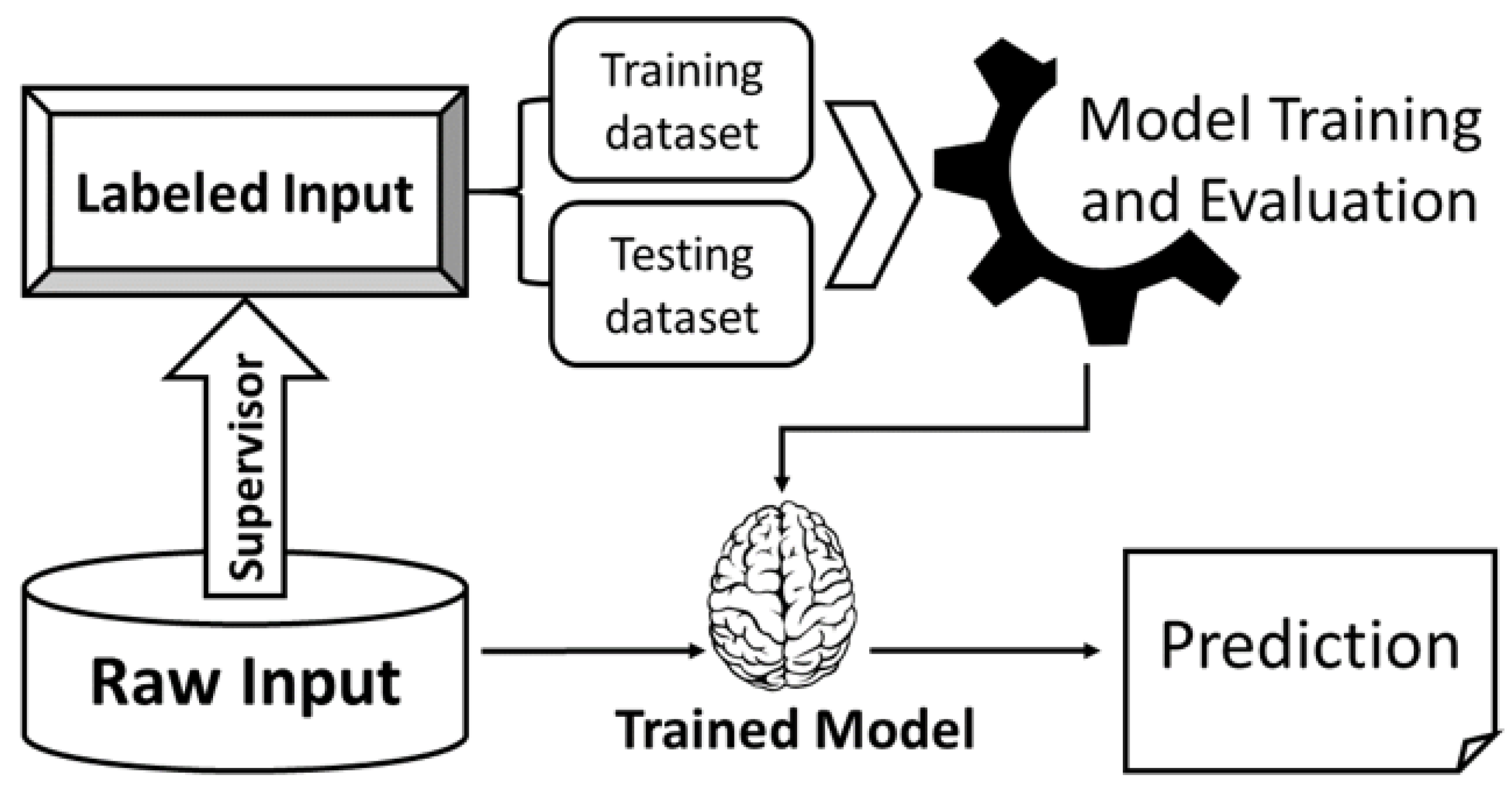

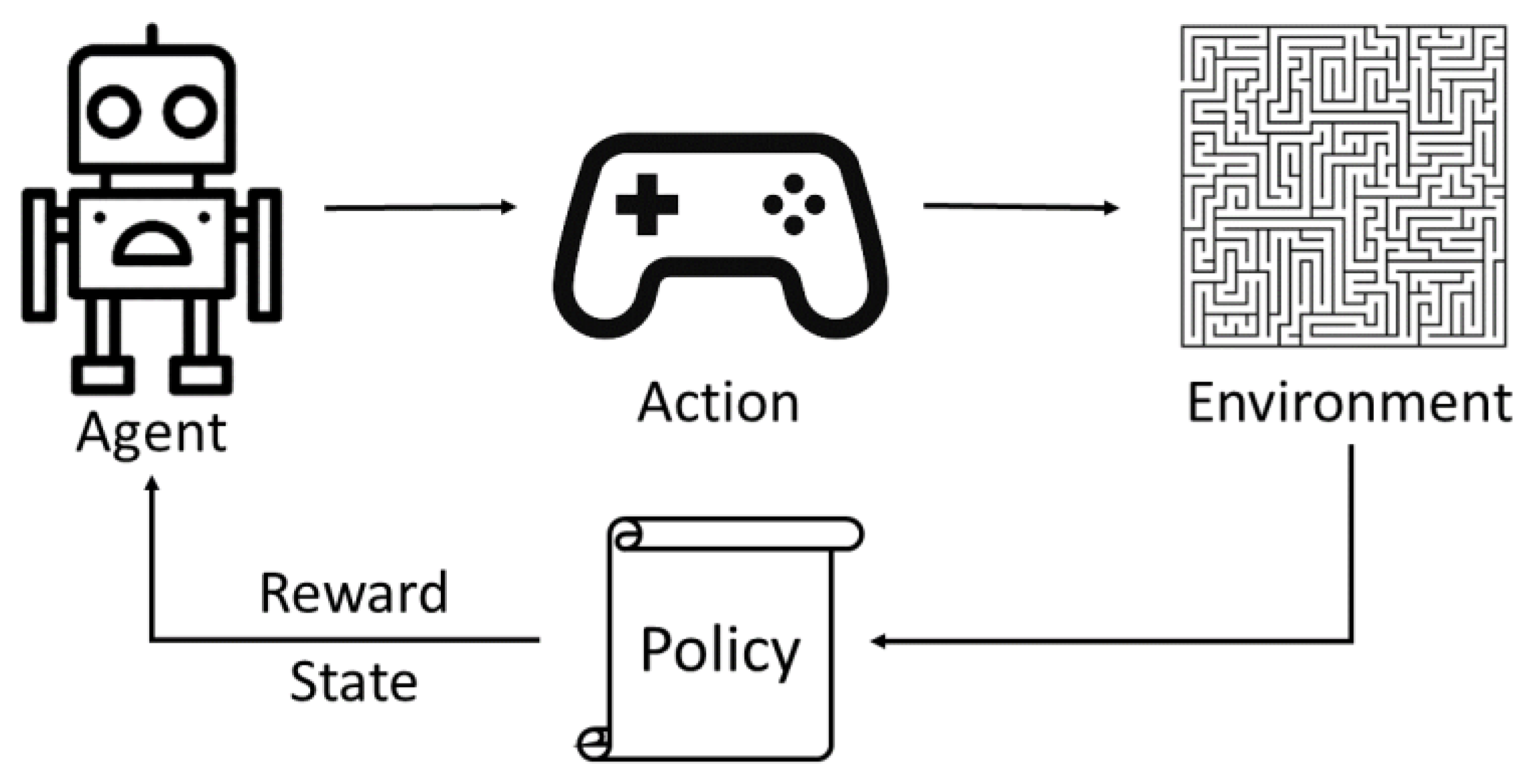
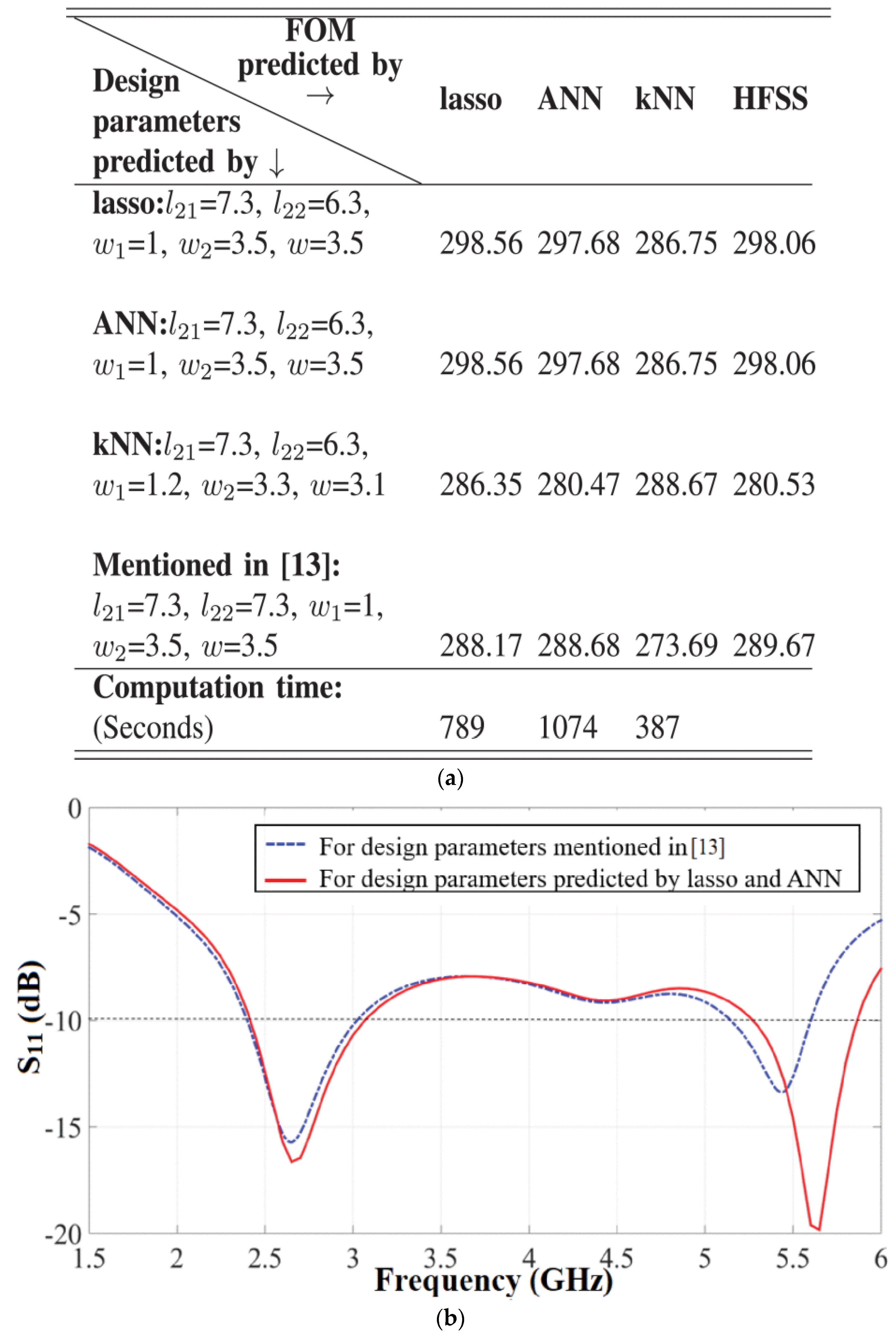
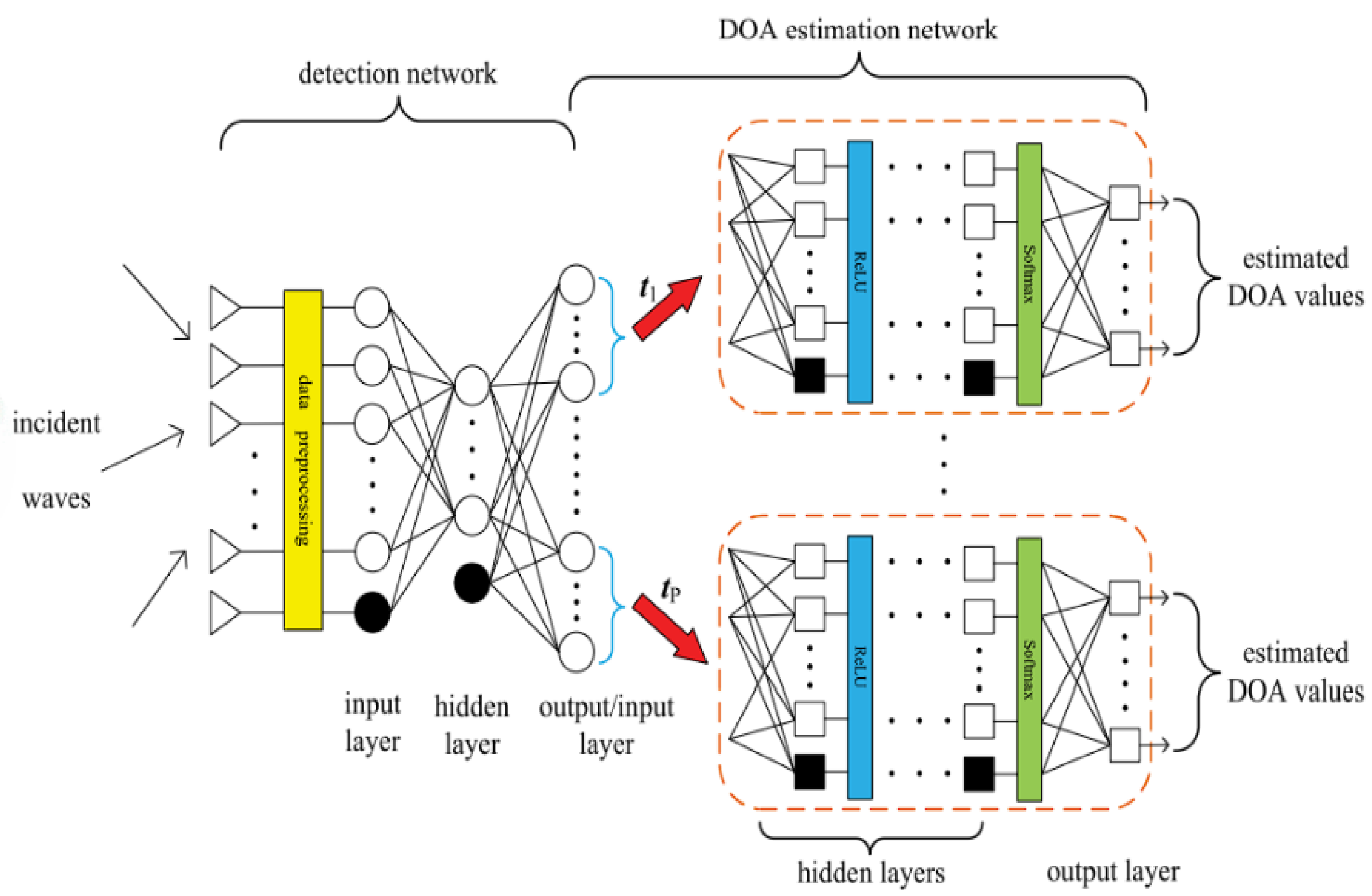
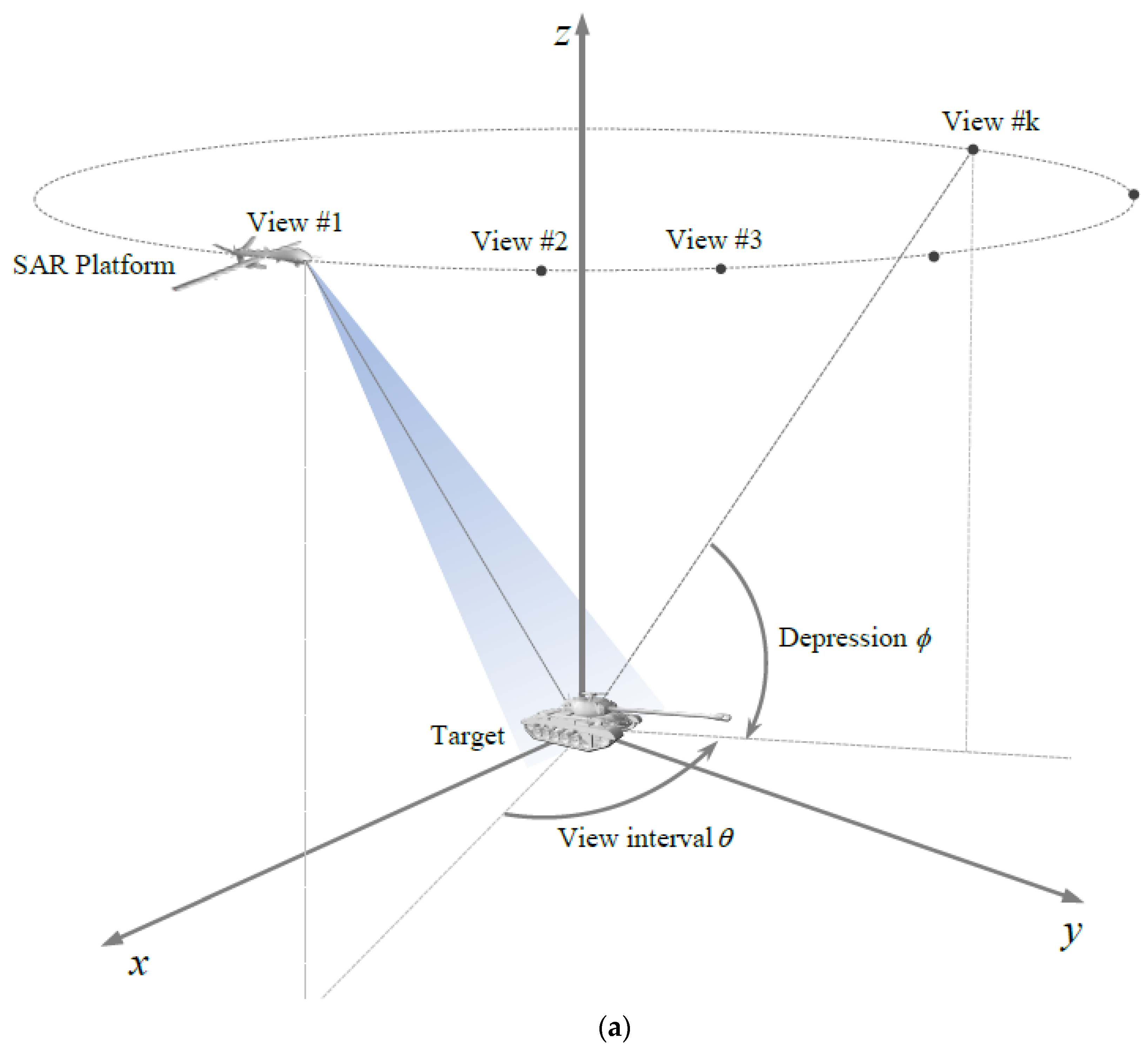
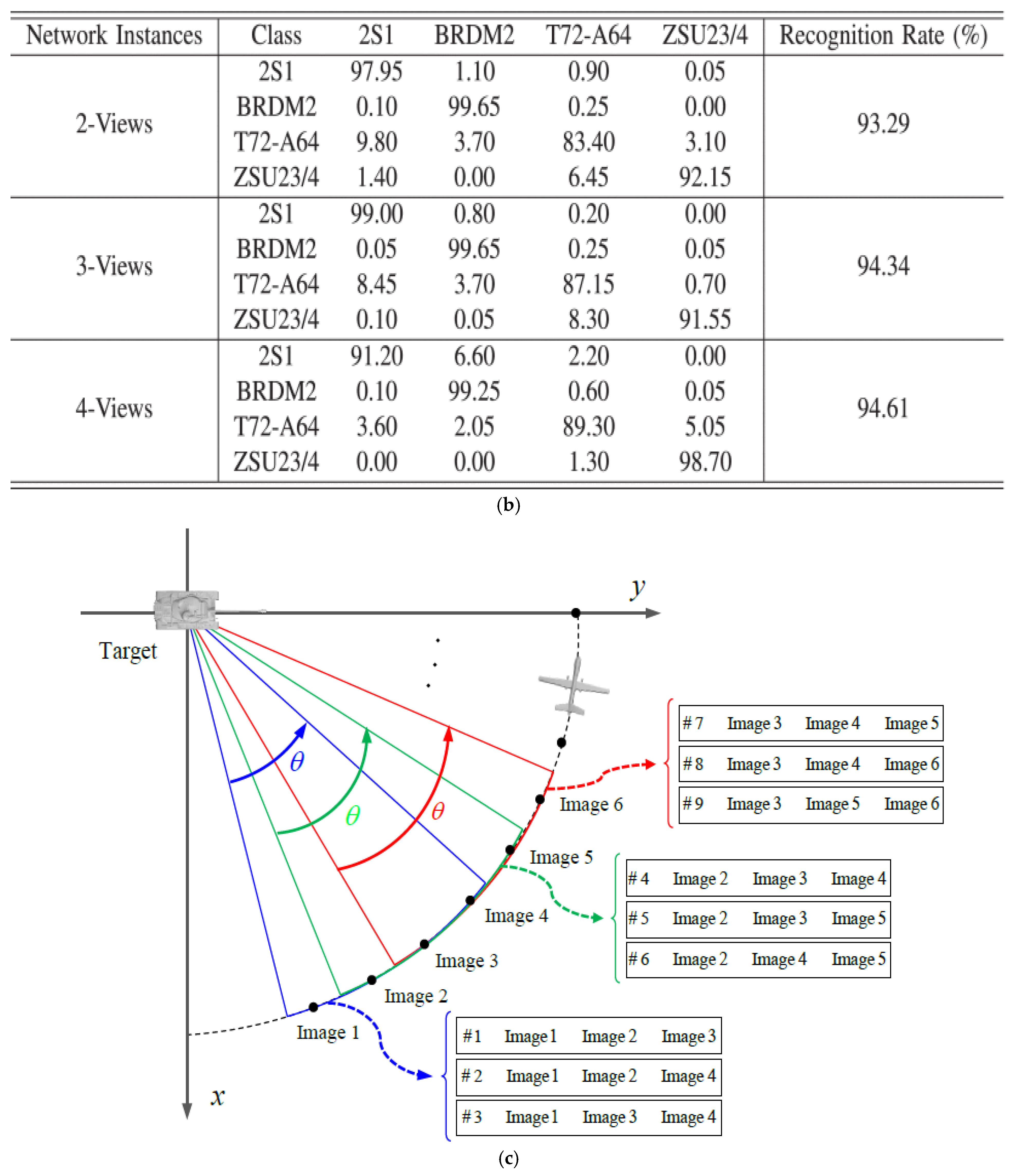
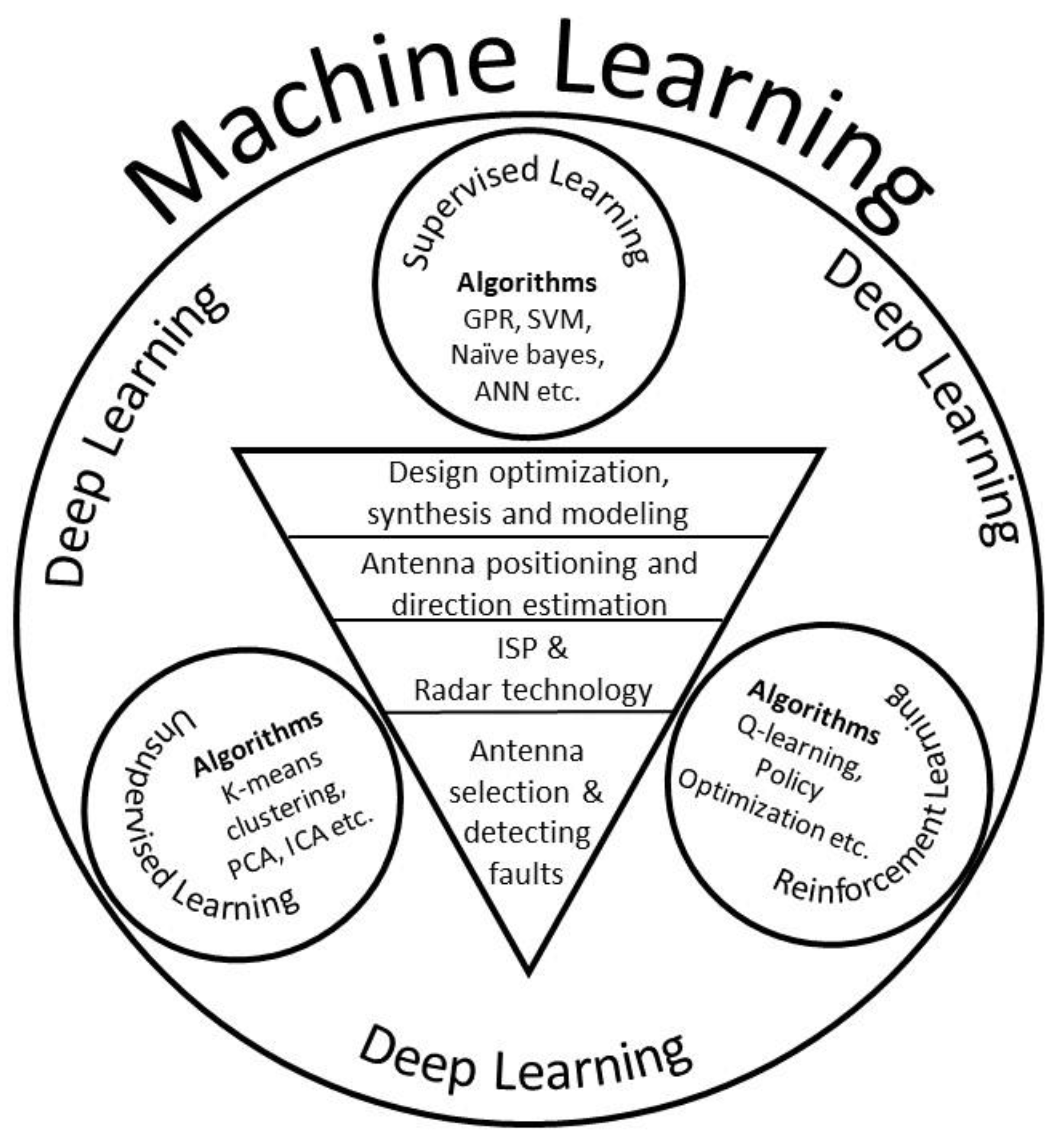
| EM Applications | Algorithms & Optimizers | Advantages | Shortcomings | References |
|---|---|---|---|---|
| Design optimization, synthesis & modeling | Surrogate modeling (single-stage, multi-stage, single- and multi-output GP modeling and differential evolution) | Inexpensive computation techniques, fast optimization with significant accuracy, self-adaptive feature for complex designs | Long models needed for better accuracy, computational complexity can be increased due to parallel simulation and hybrid structures | [21,22,23,24,25,37,39,42,44,45,46,47,48,49,51,52,53,54,55,56,57,58,59,60,61,62,63,64,65,66,67,68,69] |
| SVM, GBT, KNN | Fast design can be achieved, conditional designing with less dataset for specific accuracy, easy controlling, and modeling | Less effective in case of complex designs | ||
| Neural networks (ANN, RBF, CNN, INN and other Deep learning variants) | Higher accuracy, complex designing capability, high adaptability, fast estimation, and classification, efficient in handling large feature space | Large dataset required for optimal accuracy, may increase computational complexity for higher order deep models | ||
| Particle swarm optimization | Reduced convergence time, optimal model parameter determination | Assisting technology for other ML algorithms, performance depends on the selection of accurate models, computationally complex techniques of optimization. | ||
| Antenna selection applications | Neural networks (MLP, CNN, DL variants) | Higher diversity handling capability, higher accuracy in complex environments | Computationally complex, large dataset needed for significant accuracy with confidence | [70,71,72,73,74,75,76,77,78] |
| SVM, NB, KNN, L2S | Low computational complexity compared to exhaustive search methods and neural network variants, compatible to maintain CSI secrecy in MIMO, less affected by random noise in a dataset | Low Quality of Service (QoS) in large systems, where more elaborative functionality required | ||
| Antenna position, direction, and radiation estimation | Neural network (ANN, RNN, DNN) | Lower computational complexity with higher accuracy and reduced computational expense than other algorithms in this field, effective for DoA estimation. | Requires large dataset, may be computationally costly and complex with hybrid compound structures of the model | [24,79,80,81,82,83,84,85,86,87,88,89,90,91,92,93,94,95,96,97,98,99,100,101,102,103,104,105] |
| Genetic algorithm | Effective for complex analysis, network estimation and diversified fields of applications | Computationally complex, effective parameter handling is needed. | ||
| GPR, SVR, evolutionary algorithms | Easy to implement, significantly accurate and faster than all the other algorithms. Effective for reconfigurability estimation of antenna | Not suitable for complex problems and more prompt to be affected by dataset noise. | ||
| Remote object detection and recognition | CNN, DCNN | Model compatible data availability is high. Different variants such as Multiview, deep CNN, and dual-stream method provide higher accuracy with reduced computational complexity. | Not suitable for real-time object detection for high latency to deal with massive parameters. | [106,107,108,109,110,111] |
| Inverse Scattering Problems | Deterministic optimization methods (SOM, DBIM, CSI) and stochastic methods (GA, evolutionary optimization and PSO). | Mitigation of the challenges related to high contrast and large objects. | Less effective in solving intrinsic nonlinearity | [18,110,111,112,113,114,115,116,117,118,119,120,121,122] |
| DNN | Able to reconstruct images of the unknown scatterers. | Failure to bridge the gap between physical knowledge and learning approaches | ||
| CS-Net, residual CNN | Reproduction of high-contrast objects. | Inversion of transient electromagnetic data only. | ||
| Gradient learning, U-net CNNs | Capable of producing good quantitative results (e.g., amplitude data) | Unable to predict phase measurement | ||
| Fault Detection Systems | ANN | Display of excellent agreement with the simulation results found from its distorted radiation pattern. | Locating maximum of three defective elements in a 16-element array. | [123,124,125,126,127,128,129,130,131,132] |
| SVM | Able to detect defective elements in a 4-element array, using a different SVM for each defective element. | Not feasible with moderate or large arrays. | ||
| Bayesian optimization, Naive bayes method | Characterizing of the uncertainty of sudden antenna failure and precise detection of network failure that are hard to detect. | - | ||
| Miscellaneous applications & future scopes (5G, IoT, healthcare and distributed networks) | GA and Bayesian convolution | Optimization of the antenna parameters avoiding the pathloss and not increasing signal power effectively | Not suitable for optimizing all the parameters of a given system. | [133,134,135,136,137,138,139,140,141,142,143,144,145,154,157,162,165] |
| ANN | Optimization of dual-band antenna with desired return loss, Significant improvements in learning the modulation demodulation schemes for multipath channels in IoT applications. | Less effective for MIMO system | ||
| KNN | Maximization of the system throughput in mm-Wave communications due to ensuring the highest data rate and least mean squared error. | Unable to reduce computational complexity. | ||
| PCA | Different medical applications (e.g., prediction of breast cancer by estimating S-parameter of an ultra-MIMO sensor antenna) | Complexity to generate models for experimentation of antenna performance of wireless devices adjacent to the human body such as radiation pattern, return loss, impedance etc. |
Publisher’s Note: MDPI stays neutral with regard to jurisdictional claims in published maps and institutional affiliations. |
© 2021 by the authors. Licensee MDPI, Basel, Switzerland. This article is an open access article distributed under the terms and conditions of the Creative Commons Attribution (CC BY) license (https://creativecommons.org/licenses/by/4.0/).
Share and Cite
Sagar, M.S.I.; Ouassal, H.; Omi, A.I.; Wisniewska, A.; Jalajamony, H.M.; Fernandez, R.E.; Sekhar, P.K. Application of Machine Learning in Electromagnetics: Mini-Review. Electronics 2021, 10, 2752. https://doi.org/10.3390/electronics10222752
Sagar MSI, Ouassal H, Omi AI, Wisniewska A, Jalajamony HM, Fernandez RE, Sekhar PK. Application of Machine Learning in Electromagnetics: Mini-Review. Electronics. 2021; 10(22):2752. https://doi.org/10.3390/electronics10222752
Chicago/Turabian StyleSagar, Md. Samiul Islam, Hassna Ouassal, Asif I. Omi, Anna Wisniewska, Harikrishnan M. Jalajamony, Renny E. Fernandez, and Praveen K. Sekhar. 2021. "Application of Machine Learning in Electromagnetics: Mini-Review" Electronics 10, no. 22: 2752. https://doi.org/10.3390/electronics10222752
APA StyleSagar, M. S. I., Ouassal, H., Omi, A. I., Wisniewska, A., Jalajamony, H. M., Fernandez, R. E., & Sekhar, P. K. (2021). Application of Machine Learning in Electromagnetics: Mini-Review. Electronics, 10(22), 2752. https://doi.org/10.3390/electronics10222752









